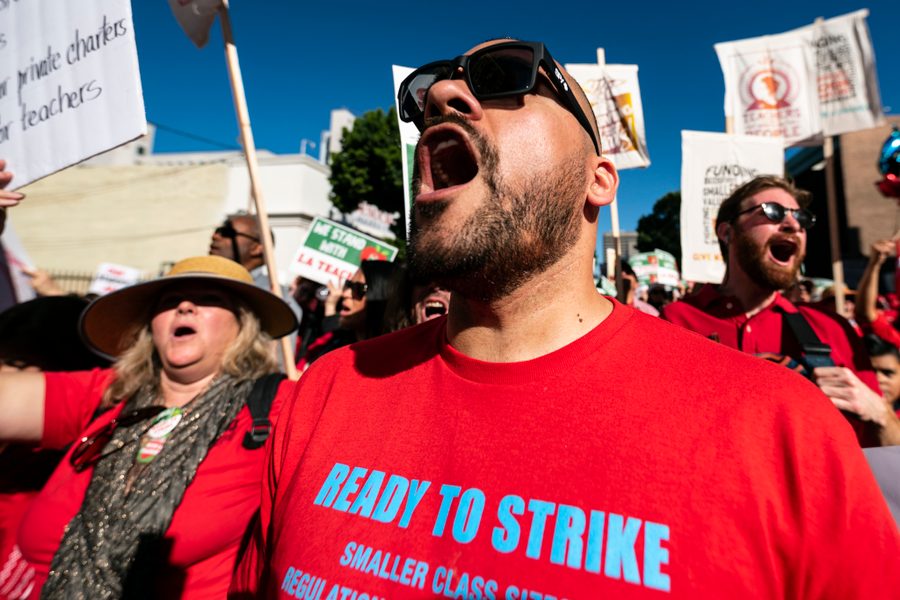In the spring of 2018, teachers across West Virginia improbably shut down schools statewide, creating a political crisis that forced Republican Gov. Jim Justice and the GOP-led legislature to back down. Drawing inspiration from the West Virginia strikers, teachers in the red states of Arizona and Oklahoma soon followed suit by carrying out statewide strikes of their own.
In his new book Red State Revolt: The Teachers’ Strike Wave and Working-Class Politics, writer and former teacher Eric Blanc details the history of these teachers strikes while providing incisive analysis, informed by his visits to the sites of these labor struggles and his access to key players which provided inside accounts of strategic and tactical debates.
By providing this on-the-ground perspective, Red State Revolt captures the exhilaration and twists and turns of these strikes. Blanc recounts how an initial Facebook group among teacher activists exploded in West Virginia, helping lead to the first tentative calls for a walkout and, in a matter of months, to the massive statewide strike of teachers and support staff. Red State Revolt shows how little steps can lead to big results.
As simply a strike history, Red State Revolt would stand as a thoughtful contribution for labor activists who could find inspiration and learn from the successes and missteps of striking teachers in these three states. Fortunately for those of us in the labor movement, Blanc drives deeper.
The core of Red State Revolt is built around of the concept of “the militant minority,” explored in depth in the longest chapter of the book. As Blanc explains: “An indispensable ingredient in the victories of West Virginia and Arizona was the existence of a ‘militant minority’ of workplace activists — that is, individuals with a class struggle orientation, significant organizing experience, and a willingness to act independently of (and, if necessary, against) the top union officialdom.”
These activists helped push their struggles forward and at key moments helped the rank-and-file contend with more conservative union officials. And, as Blanc points out, a number of these activists constituting the militant minority were socialists, though not all. As Blanc explains: “Though all genuine socialists support class struggle unionism, not all class struggle unionists support socialism.” Included in the latter category were the militant teacher leaders of the Southern former mining strongholds of Mingo County and adjacent counties in West Virginia who led a one-day strike in early February 2018 which helped set the stage for the statewide walkout later that month.
Blanc notes that many of the activists at the core of the West Virginia strike were democratic socialists inspired by Bernie Sanders’ 2016 presidential campaign, which helped motivate them to demand far-reaching changes at their workplaces. As rank-and-file West Virginia strike leader Emily Comer told Blanc, “The role of the Bernie campaign of 2016 on organizing in West Virginia really cannot be overstated. … And it got people, especially young people, plugged in who before had been feeling hopeless and who would not have made their way into organizing before.”
Like any good strike history, Red State Revolt delves into the complicated relationship between union officials, the union militants pushing the strike from below, and the rank and file workers. As Blanc explains, because West Virginia activists had built a strong statewide network leading up to and over the course of the strike, they were able to help shape the final contract agreement, continuing the walkout for another week after the initial outline of the settlement was announced until it was finalized.
By covering three strikes in three separate states, in Red State Revolt Blanc is able to compare and contrast the various strategies and outcomes. While the strikes in both West Virginia and Arizona ended on high notes, for example, the Oklahoma walkout resulted in more of a mixed outcome, along with a certain degree of demoralization.
As Blanc notes, the conditions did not initially suggest such a result. “By virtually all possible metrics, the challenges to successful strike action were greatest in Arizona,” Blanc writes. “Its right wing was considerably stronger, and its labor movement significantly weaker, than in Oklahoma — not to mention most other US states.”
Yet the crucial difference, Blanc argues, is that Arizona boasted a militant minority of activists who were able to interact with Arizona’s relatively weak teachers’ union to prod them into action and ultimately helped secure broad victories. Oklahoma, meanwhile, did not possess such a strong array of militant labor activists in the education field, which served as a liability during that state’s strike.
Teacher activists across the country will likely find Red State Revolt invaluable as the uprising shows no sign of ending. Teachers in Colorado, Washington, California and elsewhere have already since rebelled against decades of Democratic neoliberal attacks on public education. Even organizers living in such blue states will find Red State Revolt chock-full of concrete lessons.
The reality is, however, that while these public-sector strikes should give us hope, the crisis of American trade unionism lies firmly in the private sector. For many labor pundits, the lessons of the teachers’ strikes boil down to advocating bargaining for the common good or other social unionist themes. While a broad-based approach to union bargaining that seeks public support is necessary, there’s no indication that corporations will be shamed into supporting worker-friendly policies. With union density hovering at six percent in the private sector, it’s time for dramatically new approaches.
Reviving the labor movement in the private sector will require a strategy capable of breaking through legal restrictions on the right to strike. As Blanc notes, “When it comes to political strategy, there’s no need to reinvent the wheel. West Virginia and the other recent teacher revolts have confirmed the continued relevance of an old political insight: strikes are workers’ most powerful weapon.”
One question raised by the strikes in Republican-dominated states is ‘Why did the anti-union policymakers not respond with repression?’ After all, Arizona is a cesspool of reactionary anti-labor politicians, with essentially the entire power structure lined up against unions. Striking was deemed illegal in all of three states. Yet, while politicians made pronouncements indicating the strikes were illegal, they never pulled the trigger on punishing strikers.
For trade unionists, this outcome confirms the reality of what we saw in the 1960s teacher rebellion. In the 1960s, millions of public-sector workers went on strike despite the fact that striking was illegal in every state in the country. Rarely did these workers face recriminations, as politicians feared they could expand the strikes by responding with repression. The red state teacher revolts demonstrate the continued validity of the maxim that ‘there is no illegal strike, just an unsuccessful one.’
The four main takeaways from the Red State Revolt are the necessity of reviving the strike; the need for a broad-based approach; the importance of a conscious militant minority; and the ability of militant social movements to successfully violate labor law. This also serves as a prescription for the revival of the labor movement overall — one quite different from what most labor pundits have been dishing out for the past two decades.
Celebrating victories is a good thing and Red State Revolt does a great job of reliving the excitement of those strikes. Even better, however, is learning from our successes so they can be recreated over and over. That is how bigger and better movements are built.
Joe Burns, a former local union president active in strike solidarity, is a labor negotiator and attorney. He is the author of the book Reviving the Strike: How Working People Can Regain Power and Transform America (IG Publishing, 2011).








